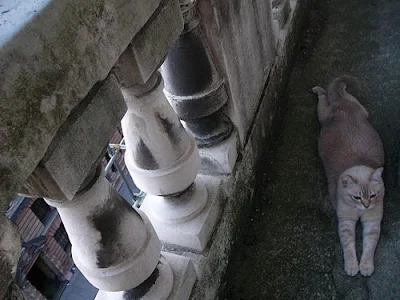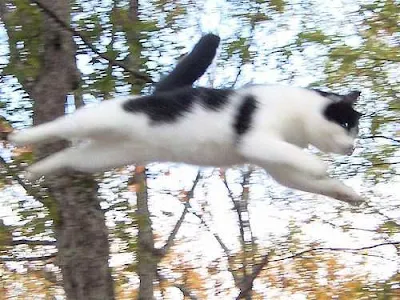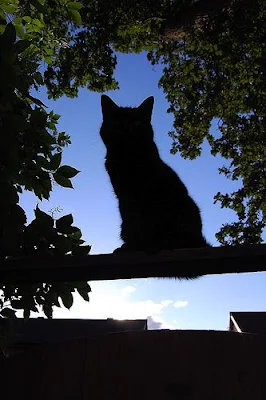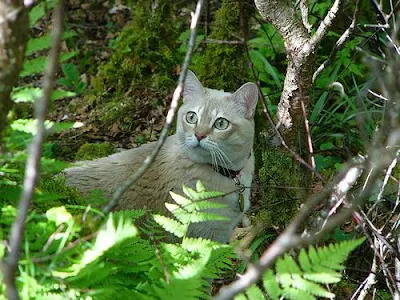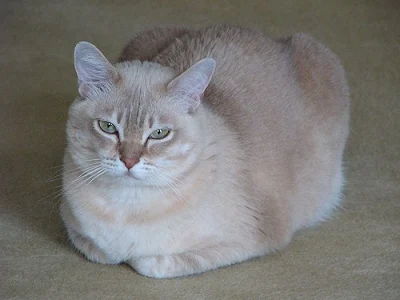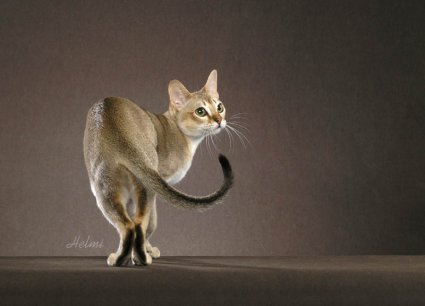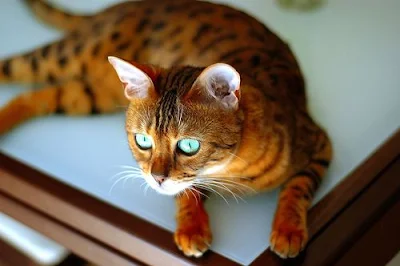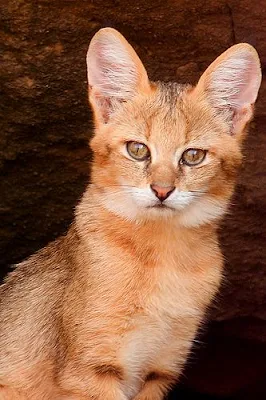If you surf the Internet as I have to learn more about the domestic cat, almost all of the information relates to the science of the domestic cat. This is useful as we can learn about a companion who is treasured by so many. How often, though, do we see something on the most important topic of all our relationship with domestic cat?
There is a convention when writing about the cat to say "it". Most cat breeders say "it" when writing or talking about cats. We call human babies in the womb, "it" sometimes. We do this because we don't know the sex.
Domestic cats play a major role in the lives of many millions of people. To describe them as "it" is disrespectful in my opinion when we know the sex. If we treat another animal as a companion (and companionship is at the heart of the relationship) we should call our companion as "she" and "he".
This is a break with convention but then convention is a reflection of a general attitude and there are many conventions that are based on ill informed views.
When my Missie was killed on the road some 14 years I cried. It was the first time my then wife had seen me cry.
When my girlfriend's father lost his dog he cried, it was the first time she had seen him cry. Our relationship with our pets is fundamental to our being. They are more than a substitute human partner. We sometimes form a relationship with them that is better than with a human. And why not? Some people joke about this but they lack enlightenment.
We are two different animals but highly compatible, that is why the cat domesticated herself some 9,000 years ago.
This wouldn't have happened but for a high degree of compatibility. The relationship is clearly more than purely functional as was the case perhaps in the beginning when the domestic cat was mouser.
It truly is possible to form a loving bond with a domestic cats.
My cat actually asks me to show her some love. She will lie on the ground and call to me to cuddle and kiss her and talk to her in a friendly voice. She loves that, it is comforting to her. She is seeking the comfort zone, a condition we all seek human animal or not.
She accepts my love but doesn't return it in a way that a human might expect or demand. She doesn't come up to me and lick my hand or rub against me unless she wants something. She doesn't know the meaning of love in human terms. But do we? Do we gloss up the idea of love? Is it simply lust which turns to practicalities seven years later?
I don't think that we are any different fundamentally. This may be hard to digest.
We both have the same fundamental will to survive and our actions are dictated by it. We certainly both have very similar anatomies.
When we talk about cats we refer to the same characteristics time a time again. Cat fanciers do most of the article writing on the Internet. A lot of the cat fanciers are breeders and they treat cats in their charge as human children.
There is definitely an element of the mother/child relationship in cat breeding. It is this relationship that often motivates a person to go into the cat breeding business. It is though more of a hobby bringing in a few pennies. The majority of cat breeders are women. Not many years ago it may have been considered "girlie" for a man to like cats. Times have changed. People are more enlightened. There is a lot of "front" or pretend going on in life.
Men like cats and need cats as much as women.
Is it really possible to have a relationship in the conventional sense with a domestic cats? No, but convention is a stupid thing very often. I don't think our relationship with cats is merely one in which we humans use cats as a creature to reflect out feelings or as a human substitute.
Sometimes this happens yes. But there is no reason why the relationship with our cats can't be exactly what it looks like, a friendly supportive relationship which helps both parties get through life.
Is there a communication barrier to the relationship that scuppers it entirely. No. There are countless thousands of successful human to human relationships in which either party could not initially understand the other because of a language barrier.
Once you know a cat communication becomes automatic. Natural and normal communication becomes established. Obviously this is not through a conventional spoken language but body movement says a lot and a cat's meow can communicate too. I know when my cat is annoyed or angry at me and when she is distressed or contented.
She asks for her meals and her grooming and attention. She asks to be let out and let in. She tells me when she wants fish or will accept canned food. She will tell me when she wants to be put down (when I have picked her up) or helped up. All the basics are there, it just takes a bit of enlightenment.
The relationship between human and cat is reinforced by the behavior of the cat. Yes it is the cat who more often reinforces and enhances the relationship in my opinion.
Domestic cats always demonstrate some desirable human qualities, qualities that we often wished we had. One is patience. My girl often gets her way through sheer patience and persistence. I have learn from that. A cat is unerringly polite, this creates stability in the relationship. A cat knows her place. At cat has no concept of ego and hierarchy, whereas dogs have.This also helps to keep the peace. Some think that male humans are more naturally inclined to form a relationship with a dog because dogs are pack animals and cats are solitary.
This implies male humans are more inclined towards being pack animals, which is generally true but not always. Women prefer cats because cats are more individual. Cats are also physically softer in appearance, some cat breeds having been developed to be cuddly fluffy dolls almost. This begs the question as to whether the development of the cat breeds has been colored by the fact that the majority of breeders are women.
Dogs are often overtly physical which appeals to men.
From the pet's standpoint dogs may prefer the company of male humans as they are more likely to make orders and dominate, which suites a pack animal. Cats being individuals are less likely to "take orders" in fact cats never take commands. The best way to get a cat to do something if she is not trained is to tease it out of her. Force a cat to do something a you will lose.
So, which type of human and which breed of domestic cat are best suited to this relationship?
Humans need to have a sensitivity towards animals generally, quite obviously, and then cats in particular. Humankind and more particularly mankind can too often hate cats. A hatred of cats can only be born out of ignorance. This is founded in what we learn as children. If our parents hate cats it is likely that we will and we will be fed misinformation by our parents as they were by their parents. Sometimes a person may say that they hate cats because they are allergic to them; 10% of people are. This is clearly no good reason to hate an animal.
It can result in injury and cruelty to cats of which there is a substantial amount in the world.
You will rarely find an unpleasant person who likes cats. A person who is cruel to animals is almost automatically a bad person. The manifestation of human cruelty to cats is a reflection of anger in that person. Anger born out of a disaffection and dislike of the world in which that person lives. This can be corrected. When a person is cruel to a cat I become angry.
I feel like doing to the person what thy have done to the cat.
From domestic cats' point of view what kind of human do they find attractive? Obviously a kind person who understands them. They see us as cats, large cats. Our size prevents or obstructs some naturally occurring events. It is difficult for a cat to head but our heads or push his face into ours to exchange scent. He'll pop up onto his hind legs to gain height and head but your hand instead. Or he'll brush against your legs. Or better still jump up onto a counter and do it for real from there.
A cat is looking for a human who understands cats and can who can behave like a cat, it's as simple as that. Women want and deserve the same degree of understanding from men.
From the human's standpoint what kind of cat do we find attractive? As the French say, chacun son truc (each to their own views). However, there are some differences between the domestic cat breeds, although these are exaggerated sometimes.
A lot of the articles on the Internet are by cat breeders or people who are in the cat fancy and who are partial to a certain breed of cat. That breed is, in their eyes, extremely intelligent and loving etc.
The differences in personality between individual cats is greater than the differences in character between the cat breeds so a discussion on cat breed characteristics is a little irrelevant. There are cultural differences between different nations of humans but we are all fundamentally the same and the differences between individuals is the biggest factor in the decision to form relationships.
The differences in cat breeds generally come from wild/cat domestic cat hybrids, which is to be expected. Although there is a great similarity between domestic cats and wild cats there are some underlying differences which are presented in the first to 3rd generation cats, By the 4th generation such hybrids are true domestic cats but with character differences. It is said that they are more intelligent, sneaky have some strange behavioral traits (to us not to them). They are more likely to want to be the boss in a multi-cat house.
The kind of relationship you'll have with a breed such as a Savannah, Chausie or and early generation Bengal is more interactive something akin to the Richard Burton/Elizabeth Taylor relationship:). The relationship can become strained and indeed some people's dream of "owning" an exotic cat becomes a bit of a nightmare. It is remarkable how many purebred cats are abandoned to cat rescue.
This can only arise out of a misunderstanding as tot the demands and in choosing a cat for the wrong reasons.
A step further would be the tamed wild cats, the Safari and Serval, both small wildcats and big domestic cats. This is a different relationship entirely and requires considerable investment in time and money on behalf of the person adopting.
At the opposite end of the spectrum you have the more sedate cats, the archetype being the Persian.
This cat breed is pretty much breed for indoor living due to her long coat and placid demeanor. For people who want a less demanding cat companion and one who can accept being alone more, this cat breed is the answer. The more natural Doll Face (traditional) Persian is lower maintenance too being less likely to have tear duct overflow (squashed face syndrome - my phrase).
The likes and dislikes of domestic cats are based on the same principles as our likes and dislikes of humans. Our first physical impression is important to us.
The rise in popularity of the exotic cats is due to an impressive appearance. That said people will, in the end, chose the soundest cat, the cat with the best overall balance of characteristics and these are possessed by the Abyssinian and Siamese.
When I say Siamese, I mean the traditional Siamese as a large majority of the public prefer the more balanced appearance of this cat. This applies to cat breeds generally. The extreme looks are created for cat breeders wishing to win shows.
The judges work in league with the cat breeders showing their cats to gradually drift to ever more extreme appearances. Cat shows are a little like fashion shows. Women don't wear the extreme clothes seen at shows, but the shows dictate the trends and goals of the fashion business at that time.
Some cats are only grey (gray) in color, these are the Nebelung, Russian Blue and Chartreux. I would have thought that men fancy this cat more than women judging by the clothes that men wear.
And women who dress more flamboyantly might find cats such as the Bengal more attractive; plenty of bling and a more assertive character too.
I think it fair to say that women may prefer male cats and visa-versa. Is this true? Not sure, but the natural order of things would support this. Although an analysis of female human behavior indicates that it is not a straightforward matter of women liking men, far from it. And I am not talking about gay people here, just the complexities of human relationships that will have a bearing on human to cat relationships.
A survey indicated that women prefer cats to men.
The human/cat relationship is generally more stable and enduring than the human to human version. The average marriage in the England is about 9 years. Most people who keep domestic cats keep them throughout the cat's life and cats in general live longer than 9 years. There are less arguments, more routine (cats love routine) and more predictability in a cat/human relationship. This stems from the cat.
A cat is supremely predictable and fairly undemanding (I thinking of mainstream mixed-breed cats here). This oils the works of the relationship. The ride is less bumpy which helps build a loving and solid relationship that can transcend a simple friendship between two different types of animal.
When the relationship reaches this state it is very rewarding. Certainly as rewarding as a marriage (provocative and controversial view perhaps - disagree? - tell me). But no substitution for a marriage.
There has to be a limit to the interaction between cat and person due to the different lifestyles and language barrier.
It could be argued that the inexorable rise in the popularity of domestic cats is linked to the consistent decline in the concept of marriage and the rise in single mothers in the UK. In the US cats outnumber dogs and the numbers are big.
The rise in cats over dogs is probably related to the decline in marriage too. People live quicker and more demanding lives. Often both parents work. The idea of the women living in the shadow of the man is long gone thankfully. This inevitably means less time for a cat or dog as a companion. Of the two, cats are less demanding. Voila, cats are the new companions of divorced women........more ramblings to come.






